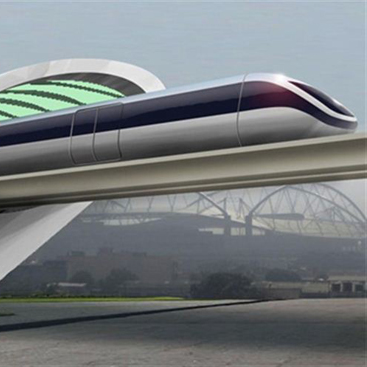Cities are the summation and densest expression of infrastructure, or more accurately a set of infrastructures sometimes working in harmony, sometimes with frustrating discord to provide us with shelter, contact, energy, water, and the means to meet other human needs. The physical infrastructure of cities consists of various structures, buildings, pipes, roads, rails, bridges, tunnels, and wires. Equally important and subject to change is the “software” for the physical infrastructure, all the formal and informal rules for operation of the system. Moreover, millennia of human development show how much we owe to the necessity of mobility to move within and between cities.
The PHE investigates the technologies and infrastructures necessary for the development of human settlements and transport systems that conserve resources, emit zero pollutants, spare the surface landscape, and provide people with expanded range.
About the icon –Rendering of the proposed ‘Hyperloop,’ a magnetically levitated train emerging from a partially evacuated tunnel
Publications about Cities and Transportation
. Is America dematerializing? Trends and tradeoffs in historic demand for one hundred commodities in the United States [external link]. Pp. 105643 in Resources Policy vol. 101, 2025 Dematerialization
. Jewish population trajectories between the Jordan River and the Mediterranean Sea [external link]. Israel Affairs vol. DOI: 10.1080/13537121.2023.2206247, 2023
. Comparative LCA of concrete with natural and recycled coarse aggregate in the New York City area (PDF). Intl Journal of Life Cycle Assessment 2017
. The Nature of the City (PDF). 2016 Presented at the workshop “Future Cities: Do Cities Have Limits?” University of Glasgow, 18 April 2016
. Cars and Civilization (PDF). The Breakthrough Journal 2014 This article was originally delivered as part of the William and Myrtle Harris Lectureship in Science and Civilization, at the California Institute of Technology on 30 April 2014 and appeared under the title "The Need for Speed: Four Basic Instincts Have Determined Human Mobility" in the Journal of the Breakthrough Institute July 14, 2014.
. Maglevs and the Vision of St. Hubert (PDF). Pp. 175–182 in Challenges of a Changing Earth, . Heidelberg: Springer, 2002 (Proceedings of the Global Change Open Science Conference, Amsterdam, Netherlands, 10-13 July 2001) maglev, St. Hubert, great restorations, farmlands, sea, forests, transportation
. Death and the Human Environment: The United States in the 20th Century (PDF). Technology in Society 23 (2): 131–146, 2001 Mortality, epidemiological transition, morbidity
. The Evolution of Transport (PDF). The Industrial Physicist 7 (2): 20–24, 2001 maglev, energy, transportation
. Toward Green Mobility: The Evolution of Transport European Review 6 (2): 143–162, 1998 maglev, transportation, energy, logistic substitution, time budgets
. Better risk information for communities (PDF). Risk Analysis 16 (5): 601–603, 1996 risk, public health
. Lightening the Tread of Population on the Land: American Examples (PDF). Population and Development Review 22 (3): 531-45, 1996 population, land use, forestry, agriculture
. Community Risk Profiles: A Tool to Improve Environment and Community Health 1995 Published by the Program for the Human Environment, The Rockefeller University, New York, NY risk, public health, community
. Ways to cut vineyard traffic and taxes (PDF). Vineyard Gazette vol. 15, 1995 transportation
. Cutting the volume of traffic on island (PDF). Pp. 15 in Vineyard Gazette 1994 transportation
. Cities and Their Vital Systems: Infrastructure, Past, Present, and Future (PDF). National Academy, Washington, D.C 1988 cities, infrastructure, urban real estate, transportation, traffic congestion, communications, water supply, distribution, wastewater
. Cities and Infrastructure: Synthesis and Perspectives (PDF). pp. 1-21 in Cities and their vital systems: Infrastructure, Past, Present, and Future, National Academy, Washington, DC 1988 cities, infrastructure, urban real estate, transportation, traffic congestion, communications, water supply, distribution, wastewater
